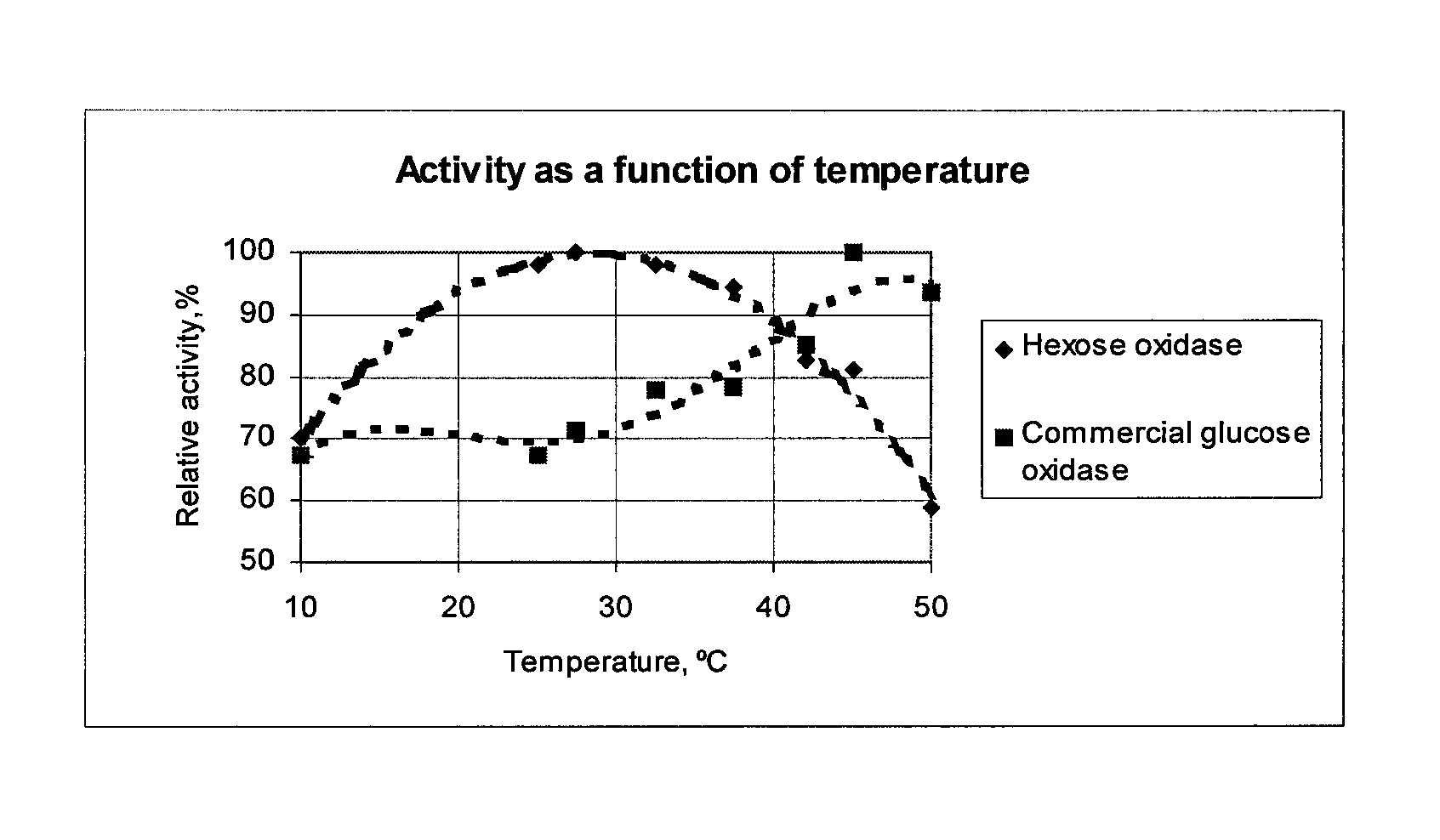Composition
a composition and composition technology, applied in the field of compositions, can solve the problems of increased fouling and glucose leaching, and achieve the effect of not losing any activity
- Summary
- Abstract
- Description
- Claims
- Application Information
AI Technical Summary
Benefits of technology
Problems solved by technology
Method used
Image
Examples
example 1
Preparation of an Anti-Fouling Composition (“One-Step”)
[0102]Soluble or immobilised hexose oxidase or another hydrogen peroxide generating enzyme such as glucose oxidase is tested as an anti-foulant compound generating enzyme in an anti-fouling composition. The hexose oxidase may be immobilised for example by binding to an anion exchanger, Q Sepharose FPM (available from Pharmacia) using 20 mM triethanolamine buffer, pH 7.3. Alternatively, hexose oxidase or alternative hydrogen peroxide generating enzymes is covalently linked to a suitable carrier such as epoxy activated Sepharose™ (Pharmacia, Sweden), carbodiimide activated agarose (Bio-Rad, USA). Other conventional procedures known in the art for immobilisation may also be utilized.
[0103]The range of concentrations used is 0.0001 to 1000 U of hexose oxidase activity / hydrogen peroxide generating enzyme per ml of anti-fouling composition. One unit of enzyme activity is defined as the amount of enzyme which produces 1 mol of H2O2 per...
example 2
Preparation of an Anti-Fouling Composition (“Two-Step”)
[0117]Glucose and galactose in concentrations of 0.01 to 100 μg per ml of anti-fouling composition are tested as substrates to generate a substrate for hexose oxidase in the systems described in Example 1. In order to provide a continuous substrate generating system, starch, preferably intact starch granules from wheat, maize or potato, in a concentration of from 0.01 ng to 100 μg per ml of anti-fouling composition, are used together with amyloglucosidase (GRINDAMYL™ AG 1500 Bakery Enzyme from DaniscoCultor or another commercial amyloglucosidase product). The components are present in concentrations providing from 0.000001 to 10 AGU per ml of anti-fouling composition.
[0118]1 AGU is defined as the amyloglucosidase activity which releases 1 μmol of glucose per minute from maltose (0.5% w / v) in 50 mM sodium acetate, pH 5.0 (adjusted with concentrated acetic acid) at 40° C. The assay is stopped by transferring 200 μl of assay mix to...
example 3
Generation of Hydrogen Peroxide by Paint Containing HOX
[0119]In order to test the ability of hexose oxidase (HOX) to generate hydrogen peroxide the following experiment was performed.
[0120]To 11.0 g of paint (water-based wall painting Sadolin Glans 7 and oil based Histor 9010, respectively) were added 0.2, 0.5 and 1 g, respectively, of HOX (DaniscoCultor fermented product from Hansenula polymorpha) spraydried on starch (10 U / g). To the water based paint was also added 5 g of water per treatment.
[0121]Disposable plastic transfer pipettes (Sarstedt) were dipped (head part) in the paint. The transfer pipettes were left to air dry for 3 hours.
[0122]Hexose oxidase (HOX) activity was then measured by immersion of the paint covered pipette head into a glass tube with 2 mL of HOX assay reagent, see below, the only HOX activity coming from the HOX in the paint.
[0123]The tubes were incubated at room temperature.
[0124]As a blank was used paint without added HOX.
[0125]The result of the experime...
PUM
| Property | Measurement | Unit |
|---|---|---|
| length | aaaaa | aaaaa |
| temperature | aaaaa | aaaaa |
| temperature | aaaaa | aaaaa |
Abstract
Description
Claims
Application Information
 Login to View More
Login to View More - R&D
- Intellectual Property
- Life Sciences
- Materials
- Tech Scout
- Unparalleled Data Quality
- Higher Quality Content
- 60% Fewer Hallucinations
Browse by: Latest US Patents, China's latest patents, Technical Efficacy Thesaurus, Application Domain, Technology Topic, Popular Technical Reports.
© 2025 PatSnap. All rights reserved.Legal|Privacy policy|Modern Slavery Act Transparency Statement|Sitemap|About US| Contact US: help@patsnap.com


